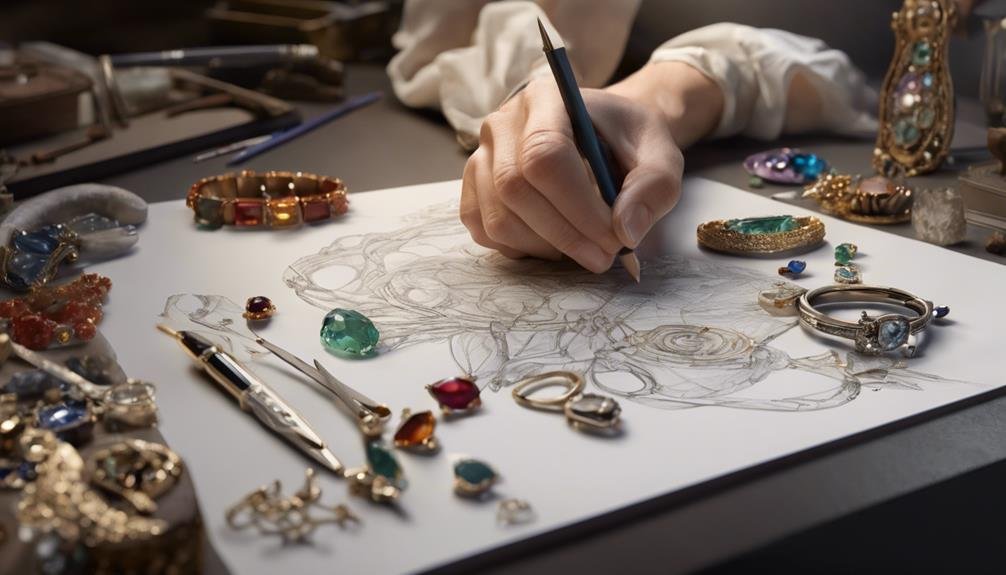Jewelry Designer Job Description
In the domain of jewelry design, artists blend creativity and precision to craft visually enthralling pieces. Responsibilities include sketching designs, selecting materials, and staying current with trends. Skills needed are artistic flair, technical proficiency, and innovative thinking. Educate yourself formally in jewelry design, fine arts, or fashion, and stay abreast of design theory and trends. Work environments are vibrant and collaborative, fostering creativity. Salary varies based on expertise, with room for growth and entrepreneurial ventures. The jewelry designer's job description invites you into a world where artistry and craftsmanship converge to shape exquisite creations.
Key Takeaways
- Embrace creativity, precision, and design principles to create visually appealing jewelry pieces.
- Translate abstract ideas into tangible designs by sketching and selecting appropriate materials.
- Stay updated on current design trends and techniques to ensure innovative and market-relevant creations.
- Possess artistic flair and technical proficiency to produce visually stunning and structurally sound jewelry designs.
- Formal education in jewelry design, fine arts, or fashion with a foundation in design theory and metalwork is essential.
Key Responsibilities
When assuming the role of a jewelry designer, one must embrace a multifaceted set of key responsibilities that encompass creativity, precision, and a deep understanding of design principles. Design concepts serve as the cornerstone of a jewelry designer's work, necessitating the ability to translate abstract ideas into tangible, aesthetically pleasing pieces. The creative process involves sketching initial designs, selecting materials, and refining the concept until it aligns with the desired vision.
Understanding design principles is crucial for a jewelry designer to guarantee that their creations are not only visually appealing but also structurally sound. This involves considering aspects such as balance, symmetry, and proportion in every piece crafted. The creative process often involves experimentation with different techniques and materials to achieve the desired look and feel of the jewelry. By staying abreast of current design trends and techniques, a jewelry designer can bring fresh perspectives to their work and captivate the hearts of their audience with innovative creations.
Required Skills
To excel as a jewelry designer, one must possess a diverse range of essential skills that encompass artistic flair, technical proficiency, and a keen eye for detail. Design techniques play a pivotal role in creating unique and alluring jewelry pieces. Understanding different materials, colors, and textures is vital to crafting innovative designs that resonate with the target audience. Additionally, staying updated with market trends is important to guarantee that the designs remain relevant and appealing to consumers. A successful jewelry designer not only creates visually stunning pieces but also considers the practicality and comfort of the wearer.
| Required Skills | Description |
|---|---|
| Artistic Flair | Ability to conceptualize and create visually appealing designs. |
| Technical Proficiency | Proficient in using design software and understanding manufacturing processes. |
| Attention to Detail | Meticulous in ensuring precision and quality in the finished products. |
| Market Trends Awareness | Stay updated with the latest trends and consumer preferences in the jewelry industry. |
| Creativity | Ability to think outside the box and innovate new design concepts. |
Educational Background
A solid foundation in jewelry design principles and techniques is essential for aspiring designers to develop their craft and spark their creativity. While formal education is not always a strict requirement, many successful jewelry designers hold a degree in fields such as jewelry design, fine arts, or fashion design. These degree programs offer courses that cover design theory, metalwork, gemology, and business aspects of the industry.
Additionally, pursuing certification options from reputable organizations can enhance a designer's credibility and knowledge base. The Gemological Institute of America (GIA) and the Jewelry Arts Institute are examples of institutions that offer certification programs in various aspects of jewelry design and gemology.
Having a degree in jewelry design or a related field not only provides designers with technical skills but also exposes them to art history, design trends, and the business side of the industry. In a competitive market, a solid educational background can set designers apart and open up opportunities for career advancement.
Work Environment
In the world of jewelry design, the work environment is a dynamic and inspiring space where creativity flourishes and craftsmanship is honed to perfection. Jewelry designers often work in bright, airy studios filled with natural light, providing the ideal setting for their creative process. The atmosphere is buzzing with energy as designers collaborate with skilled artisans, gemologists, and other professionals to bring their visions to life.
Team collaboration is at the heart of the jewelry design work environment. Designers often work closely with other team members, bouncing ideas off each other, receiving feedback, and collectively problem-solving to overcome design challenges. This collaborative spirit fosters a sense of camaraderie and shared achievement among team members.
Creative inspiration is everywhere in a jewelry design studio. From mood boards adorned with color palettes and sketches to shelves displaying precious gemstones and intricate findings, every corner is designed to spark imagination. Designers draw inspiration from a myriad of sources, from nature's beauty to architectural marvels, ensuring that each piece they create is a unique work of art. With a supportive team and a creatively stimulating environment, jewelry designers can truly thrive and push the boundaries of their craft.
Career Opportunities
Within the domain of jewelry design lies a plethora of alluring career opportunities waiting to be explored and embraced. As a jewelry designer, salary expectations can vary based on factors such as experience, expertise, and the type of jewelry being designed. Entry-level designers may start with salaries around $30,000 to $40,000 per year, while seasoned professionals or those working with luxury brands can earn well over $100,000 annually.
Job growth opportunities in the field of jewelry design are promising, with an expected 3% increase in employment projected over the next decade. This growth rate is in line with the average for all occupations, indicating a steady demand for skilled jewelry designers. Designers who are versatile in their skills, keep up with industry trends, and are open to exploring new technologies like 3D printing can position themselves for even greater job prospects. Additionally, freelance opportunities and the chance to start one's own jewelry line provide avenues for entrepreneurial-minded designers to thrive in this creative industry.
Conclusion
To sum up, a jewelry designer is accountable for crafting distinctive and elaborate pieces of jewelry, employing their expertise in design, imagination, and artistry.
With a foundation in jewelry design or a connected field, designers operate in a creative and cooperative setting to actualize their visions.
Despite the cutthroat nature of the sector, jewelry designers have the chance to exhibit their skills and leave a lasting impression in the realm of fashion and art.







